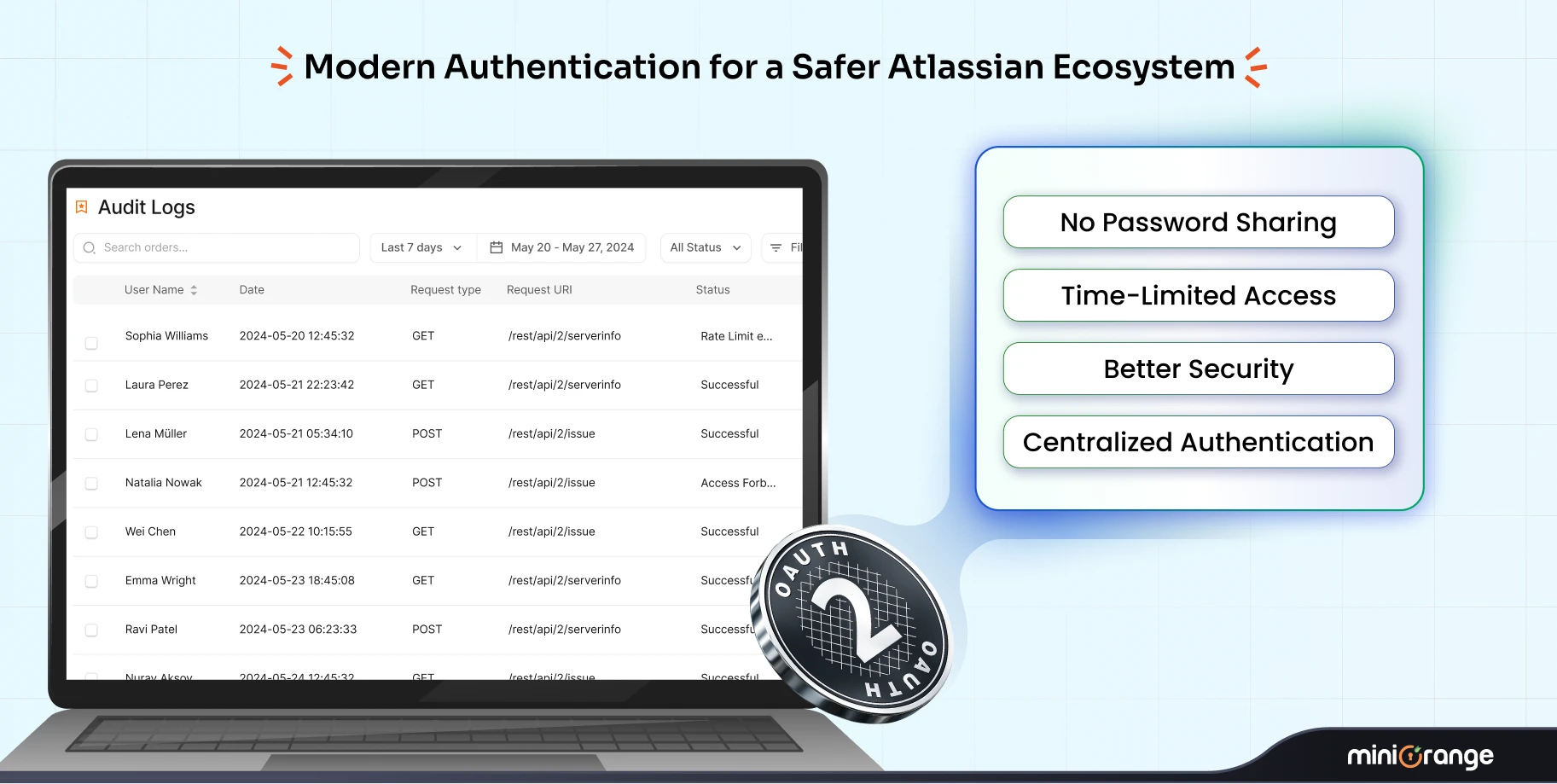Why Choosing the Right MFA Method Matters
When it comes to protecting your Atlassian environment, enabling MFA is no longer optional. It is table stakes. But here is the catch: choosing the wrong MFA method can be almost as damaging as having none at all.
Pick a method that is too slow or inconvenient and your users will push back, delay adoption, or flood your IT team with support tickets. Pick one that is too weak and you leave the door open to credential theft, phishing, and account breaches.
Atlassian admins today have four main options: SMS codes, email verification, time-based one-time passwords (TOTP), and push notifications. Each option has different strengths, weaknesses, and ideal use cases. The right choice depends on your users, your infrastructure, and the level of security your organization needs.
This guide will break down each method, compare them side by side, and help you find the balance between security, usability, and compliance so your MFA strategy works for both your admins and your end users.
Understanding Your MFA/2FA Options in Atlassian
Multi-factor authentication (MFA) enhances your Atlassian security by requiring users to verify their identity using multiple methods. Two-factor authentication (2FA) is the most common MFA form, combining something users know (password) with something they have or receive (a code, device, or biometric).
For Atlassian admins looking for a flexible and comprehensive 2FA solution, the miniOrange Atlassian 2FA app is a top choice. It supports nine authentication methods within a single platform, making it easy to tailor security to your organization’s needs.
IT also incorporated some of the most popularly used 2FA methods:
- OTP Over SMS — One-time codes sent via text message to users’ phones.
- OTP Over Email— Codes or links sent to registered email addresses.
- Time-based One-Time Passwords (TOTP) — Generated by authenticator apps like Google Authenticator or Authy, these codes are time-sensitive and highly secure.
- Push notifications — Quick, one-tap login approvals sent to users’ mobile devices.
These methods provide admins flexibility to customize the MFA experience to the organization’s exact security and user experience needs.
Now that you know the range of MFA methods available, let’s explore the most commonly used options in detail.
OTP Over SMS 2FA Method: Simple but Potentially Risky
SMS-based two-factor authentication sends a one-time code to users via text message when they log in. It’s widely familiar and easy to adopt, making it a popular choice for many organizations.
Pros:
- Easy to use and set up—most users are already familiar with receiving SMS codes.
- Does not require users to install additional apps or software.
- Works on any mobile phone with SMS capability.
Cons:
- Vulnerable to SIM swapping attacks, where attackers hijack a user’s phone number to intercept codes.
- Susceptible to interception through SS7 protocol vulnerabilities and phishing scams.
- Relies on mobile network availability, which can be inconsistent in some areas.
Best For:
- Government agencies and regulated industries where employees use secure/encrypted phones or dumb phones without app support.
- Teams needing a quick, low-friction 2FA option that does not require installing apps.
- Environments with moderate security requirements where convenience is a priority.
While SMS 2FA offers a straightforward layer of security, its vulnerabilities mean it should not be the sole method for protecting sensitive Atlassian accounts, especially in high-risk environments.
OTP Over Email 2FA Method: Accessible for All
Email-based two-factor authentication sends a one-time password or verification link to a user’s registered email address. This method is easy to implement and requires no additional hardware or apps.
Pros:
- Accessible to all users with an email account.
- No need for separate authenticator apps or devices.
- Easy for admins to manage and monitor.
Cons:
- If a user’s email account is compromised, attackers can intercept codes.
- Email delivery delays can slow down login.
- Phishing attacks targeting email accounts remain a risk.
Best For:
- Organizations with strong email security controls protecting user inboxes.
- Teams where users may not have smartphones or prefer not to use authenticator apps.
- Use cases where convenience and ease of access need to be balanced with reasonable security.
Email 2FA is a good option for organizations seeking simplicity and broad accessibility, but it should ideally be paired with strong email security practices to mitigate risks.
TOTP Apps: A Balance of Security and Usability
Time-based One-Time Passwords (TOTP) generate short-lived codes using authenticator apps like Google Authenticator, Authy, or miniOrange Authenticator. Users enter these codes during login as a second verification factor.
Pros:
- Highly secure and resistant to phishing attacks.
- Generates codes locally on the device without needing internet or cellular connection during login.
- Widely supported across many platforms and services.
Cons:
- Requires users to install and set up an authenticator app.
- Some users may find app setup confusing or inconvenient.
- Device loss or reset can complicate account recovery.
Best For:
- Organizations with a security-first mindset looking to minimize risk.
- Teams comfortable with using mobile apps for authentication.
- Environments where phishing resistance and offline capability are priorities.
TOTP strikes a solid balance between usability and security, making it one of the most popular 2FA methods for Atlassian users.
Push Notifications: Secure and User-Friendly
Push notification-based MFA methods like Duo Push Notification send a login approval prompt directly to the user’s mobile device. Instead of entering codes, users simply tap Approve or Deny to verify their identity.
Pros:
- One-tap convenience speeds up the login process.
- Highly phishing-resistant since there’s no code to intercept or reuse.
- Provides real-time alerts of login attempts, improving security awareness.
Cons:
- Requires users to have a compatible smartphone with internet connectivity.
- Dependence on mobile device availability can be a limitation if devices are lost or offline.
- May require additional app installations depending on the provider.
Best For:
- Organizations prioritizing strong security combined with seamless user experience.
- Teams where users have reliable access to smartphones and mobile data.
- Environments looking to reduce friction and support tickets related to 2FA.
Push notifications offer a modern, efficient way to secure Atlassian accounts without sacrificing usability.
How to Choose the Right MFA Method for Your Atlassian Environment
Choosing the best MFA method depends on balancing security, usability, and your organization’s specific needs. Consider these key factors when deciding:
1. Security Requirements: Evaluate how sensitive your data and workflows are. High-risk environments like finance or healthcare may require stronger, phishing-resistant methods such as TOTP or push notifications. Less sensitive setups might accept SMS or email as a starting point.
2. User Base and Device Availability: Understand your users’ typical devices and capabilities. If many users rely on basic phones without apps, SMS or email might be more practical. For users with smartphones, push notifications or TOTP apps provide better security.
3. User Experience and Adoption: Friction in login can reduce adoption of MFA. Push notifications offer quick, one-tap approvals that minimize disruption, while TOTP apps require initial setup. Consider what your users are comfortable with.
4. Compliance and Policy Requirements: Some industries require specific MFA methods or higher assurance levels. Make sure your chosen method aligns with regulations like GDPR, HIPAA, or government mandates.
5. Recovery and Support: Think about account recovery processes and the support burden on your IT team. Methods that are easier to recover, such as backup codes or security questions (offered by miniOrange), can reduce help desk tickets.
Many organizations find that combining multiple MFA methods through a flexible platform like the miniOrange Atlassian 2FA app offers the best balance, allowing users to choose or admins to enforce methods based on roles, risk levels, or other policies.
Setting Up MFA in Atlassian with miniOrange
Implementing MFA for Atlassian users is straightforward with the miniOrange 2FA app. The platform supports all nine MFA methods, giving admins the flexibility to enforce the right option for each user or group.
Step-by-Step Setup Process:
1. Install the miniOrange 2FA App
Navigate to the Atlassian Marketplace and add the miniOrange Two Factor Authentication app to your Jira or Confluence instance.
2. Choose 2FA Methods
The miniOrange 2FA app supports nine MFA methods, including OTP over email/SMS, TOTP apps, security questions, hardware tokens, and more. From the configuration screen, simply select your desired methods and toggle them on.
3. Enable a Backup Method
A backup authentication method ensures users can still log in if their primary MFA method is unavailable. For example, if they lose a device or change their phone number. Simply choose one of the available MFA options as the backup and toggle it on. This reduces lockouts and lowers helpdesk requests.
4. Select Users to Enforce 2FA
Decide which users must use MFA and how it is applied:
- All users: Enforce MFA for everyone, including new accounts automatically.
- Specific users or groups: Apply MFA only to selected roles or teams.
- Conditional enforcement: Skip MFA for trusted IP ranges or certain admin-approved exceptions.
This flexibility allows you to protect critical accounts without disrupting every user.
5. Choose Where to Enforce 2FA
Select the Atlassian products where MFA will be required; Jira Software, Jira Service Management, or both. For added protection, enable MFA for Jira WebSudo, which prompts admins to complete an MFA challenge before performing sensitive actions, even if they are already logged in.
6. Set Your 2FA Policy
Admins can decide whether MFA is mandatory or optional for users:
- Mandatory: All users must set up MFA before they can access the platform.
- Optional: Users can choose whether to enable MFA on their accounts.
Conclusion: Strengthen Atlassian Security with the Right MFA
Choosing the right MFA method is more than just a security checkbox, it’s about finding the balance between protection and usability for your Atlassian users. Whether your team prefers the simplicity of push notifications, the familiarity of SMS, or the high assurance of hardware tokens, miniOrange makes it easy to offer the right method to the right users.
With support for nine different MFA methods, flexible enforcement rules, and backup options, the miniOrange 2FA app gives Atlassian admins full control over authentication without slowing down productivity.
Frequently Asked Questions (FAQs)
Q1: Can users have multiple 2FA methods enabled at the same time with miniOrange?
Yes. The miniOrange 2FA app supports multiple methods per user, allowing admins to enable backup options or let users choose their preferred authentication method for flexibility and improved account recovery.
Q2: What happens if a user loses access to their primary 2FA device?
If a user loses access, they can use a pre-configured backup method such as backup codes, security questions, or an alternate MFA option enabled by the admin. This ensures continuous access while maintaining security.






Leave a Comment